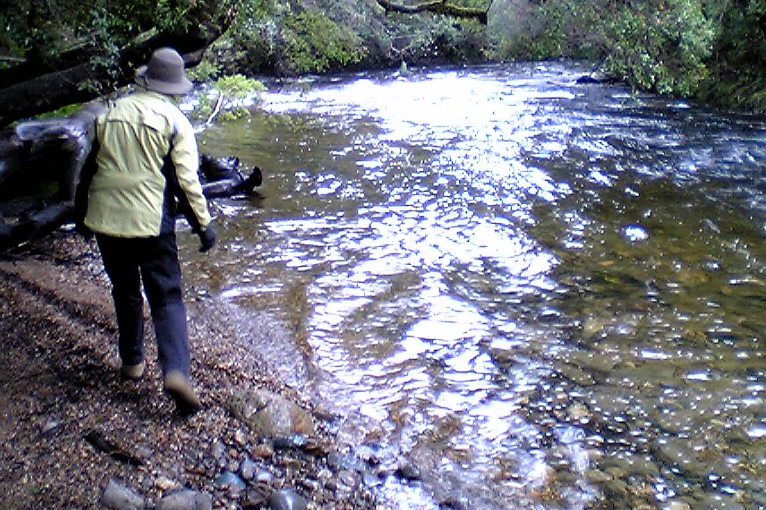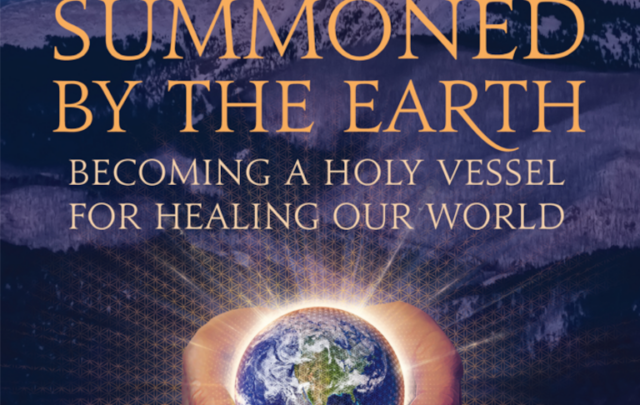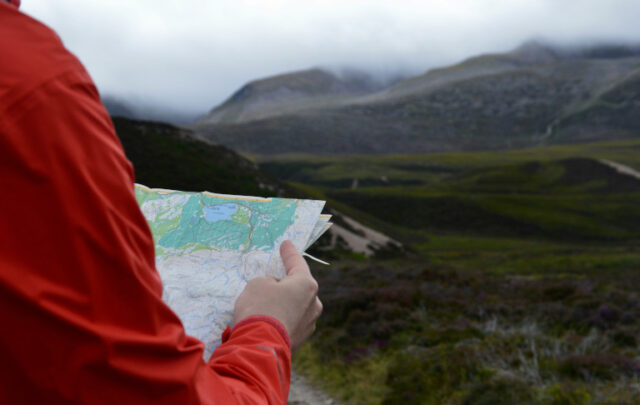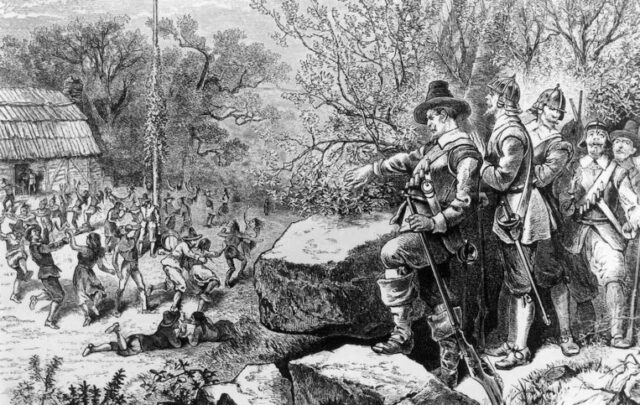I didn’t notice the clouds at first.
I had stepped out of the stuffy hotel onto a busy sidewalk in downtown St. Louis to clear my head and maybe find a decent cup of coffee. It was mid-afternoon on a warm day in late August, 2005, and the moist air stuck to my skin immediately, displacing the chill of the hotel air conditioning. It felt like a relief. So did the grumbly noise of traffic in the street, oddly comforting even though I hadn’t lived in a big city for years. Slipping into a stream of mostly young, well-dressed professionals, I followed a group of them toward an intersection, perfectly happy to be swept along. All I wanted from my jaunt was a dose of the outside world to counterbalance the conference fairyland I had been attending for the past two days. This always seems to happen. Despite promises to myself there comes a point in almost every conference I’ve attended when the alternate universe of thoughtful presentations, earnest conversations, and world-saving plans formulated over lunch salads begs to be punctured by sunlight and the smell of diesel.

This event in particular had made it difficult to remain cloistered. The three-day conference was organized by the White House and although I was honored to be invited, my expectations were low. I labored to stay in my seat through the highly scripted keynote speeches and carefully designed break-out sessions. The topic was ‘Cooperative Conservation’ and the event’s stated goal was to celebrate an Executive Order signed recently by President George W. Bush directing federal agencies to cooperate with state, tribal, and local governments, as well as private citizens, to conserve natural resources. On its face, the conference looked like a worthy endeavor. In reality, it was a publicity stunt. The business-friendly Bush Administration, led by a former Texas oilman, had not been kind to the natural world in its first term and it was about to get much worse. Three weeks earlier, President Bush signed the Energy Policy Act, a partisan bill that not only provided generous tax incentives to corporations for expanded oil-and-gas exploration, it also exempted chemical fluids used in a new technology called hydraulic fracturing, or fracking, from regulation under the Clean Water Act. If spilled on the ground or into waterways, these fluids can be toxic to wildlife.
There was nothing cooperative about that, of course.
On the first day of the conference, I sat quietly as Secretary of Defense Donald Rumsfeld gave a speech to the large audience, which included many of my nonprofit peers, touting his agency’s efforts to protect wildlife habitat on American military bases while not once mentioning the huge environmental toll being levied on Iraq as a consequence of the ongoing war. So it went. The platitudinous parade of Administration officials and political allies was lengthy. Making matters worse, the White House was late to the game. Collaborative conservation began as a grassroots movement led by ranchers, farmers, and conservationists with a few brave scientists and federal land managers thrown into the mix. Its aim was to break a bitter, decades-old conflict over working landscapes, particularly on public lands, by exploring what we shared in common rather than continue to argue our differences. We called ourselves the ‘radical center’ and we had a simple goal: work together across property lines to get positive things done on the ground. It succeeded. The movement took hold and grew. And it did so, frankly, despite the Bush Administration, though you would never know it by listening to the speakers at the conference. I didn’t mind. The event marked the collaborative conservation’s ‘coming out’ party, for which I felt proud. We were moving from the fringe to respectability. Hopefully, that meant more good things would happen on the land.
Reaching the busy intersection with the pod of young professionals, I waited to cross the street, soaking up the vibrancy of the urban world all around me, with its tall buildings and endless energy. Despite living in a small town in the high desert of New Mexico and working professionally with ranchers and fellow conservationists, part of me missed the juice of big cities. In our roaring twenties, Gen and I lived in Los Angeles, indulging ourselves on weekends with the great city’s sunny exuberance. The land of possibilities, convertibles, and expensive lattes, LA mesmerized us with its many charms, including its ocean-tinted air. I also missed the soft sunlight. There wasn’t any sun in St. Louis today, I noticed. Still waiting to cross the intersection, I looked up casually into the sky. There were clouds. I suddenly felt a chill in the warm, sticky air. They appeared to be ordinary clouds, smooth and gray, thinner to the north, thicker and darker to the south, as if a storm were approaching.
Or a hurricane.

The pod began to move. I lowered my gaze and followed them across the intersection. Were the clouds remnants of Hurricane Katrina, I wondered? Yesterday, a television in the hotel lobby broadcast nonstop images of the storm as it unleashed its fury on the coasts of Louisiana and Mississippi. Trees bent, wind whipped, and rain slashed while drenched newspeople stood bravely before their cameras reporting on the huge hurricane. I fretted about the emergency, but not overly so. In a way, Katrina wasn’t news. The 2004 hurricane season had been busy, deadly, and destructive. Dominated by four major storms, including a monster named Ivan, the season wracked up nearly sixty billion dollars in damage from the Bahamas to Louisiana and killed more than three thousand people, setting modern-day records. This year looked to be a repeat. Already, 2005 had produced four major hurricanes, including a drencher in mid-July named Emily, the earliest Category Five hurricane ever recorded in the Atlantic. The next big one, Katrina, organized itself six days ago and had clipped the tip of Florida as a Category One hurricane just before I flew to St. Louis. At last report, it seemed to be weakening. I didn’t give the storm another thought until Sunday when I turned on the television in my room. Juiced by unusually warm water in the Gulf of Mexico, Katrina had exploded into a Category 5 behemoth and barreled toward into the coast. Fortunately, the hurricane appeared to weaken before striking land, which was a small relief. Things looked serious, but not catastrophic.
Then New Orleans drowned.
I reached the far sidewalk and kept walking, now lost in thought. Although nearly all communication with New Orleans had been lost, reports were trickling out about extensive damage and significant loss of life. More than one million residents had heeded Mayor Ray Nagin’s mandatory evacuation order, but it was estimated that nearly one hundred thousand people remained in the city, now stranded by rising waters and without power. There was a report that thousands of people were taking shelter at the Superdome. I looked back up at the gray clouds. Jesus, I thought to myself. What the hell happened? I kept walking. The chill I felt earlier took on an ominous tone. Was Katrina a harbinger of things to come? It felt like it. Experts told reporters they were surprised by how fast and how big the hurricane had grown. In one interview, a scientist said Katrina’s expansion was unprecedented in the annals of Atlantic storms. That didn’t sound good. Hurricanes are isolated events, of course, but they are also part of an interlocking system of short-term weather and long-term climate trends. What did “unprecedented” mean in this case? Was it a signal of things to come?
As I walked, I recalled a conversation I had a year earlier with Craig Allen, a forest ecologist and colleague stationed at a nearby national park, who stopped by my office in Santa Fe to catch up. When I first met Craig years earlier his work focused on how forests change over time. What he discovered was troubling. Specifically, he worried about the rapid growth of dense stands of thin trees, a result of decades of fire suppression. His research revealed that grassy mountain meadows were shrinking at an alarming rate due to tree encroachment. The problem was fire – there wasn’t enough of it. Or when forests did burn, the fires often became unnaturally huge, destructive conflagrations. Most forests evolved with frequent, low-intensity fires, but the federal policy of total fire suppression meant these ecosystems were now severely out-of-whack.
In the next phase of his career, Craig focused on forest restoration, including tree stand thinning projects and carefully targeted prescribed fires. As a result of this work, Craig joined a growing chorus of ecologists advocating for proactive policies aimed at returning ecosystems to health. It was collaborative conservation at work. It wasn’t enough to simply ‘preserve’ a forest anymore, not if that meant keeping it in an unhealthy state. Forests needed hands-on, scientifically-guided, collaborative restoration. However, the world kept changing and soon Craig began to focus his research on the threat of global warming. His goal was to figure out ways to keep a forest healthy in the face of a changing climate, more frequent drought in particular. Unfortunately, Craig’s research told him things didn’t look rosy under Business-as-Usual scenarios. “The possibility exists,” he told me that day in the office, “that a 5 degree Celsius warming of the planet could wipe out entire plant communities, including the forests.”
But it’s what he said next that really caught my attention.
He had been asked to speak to a gathering of federal land managers about how to meet the challenge of increasingly hotter and drier conditions. “What they told me,” Craig said, “was that nothing in their education or experience had prepared them for what was coming down the road in terms of climate. Their training was for a stable climate, not one that was changing. They literally had no idea what to do. They were facing an unprecedented future for which they were not prepared.”

I looked up at the clouds again as I walked. The ominous feeling grew. Had our unprecedented future begun? New Orleans wasn’t prepared, clearly and tragically. The city was suffering. People were dying. But it was an isolated event, right? I turned a corner. I hadn’t been paying much attention to the world beyond cattle, grass, and people, to be honest. Climate change? I knew it was a topic of discussion among some of my fellow conservationists and I was vaguely aware of the public “debate” between climate scientists and non-expert denialists, but I hadn’t given the subject much thought until now. Besides, it wasn’t a topic of discussion among ranchers, even the progressive ones we worked with out on the land. It certainly wasn’t on the agenda of the White House conference. Still, the dark clouds overhead suggested something was in the air, literally. I decided to head back to the hotel. I wanted to see the latest developments taking place in New Orleans, hoping there would be good news. I also wanted to do a little research online about climate change to see if my intuition about Katrina being a harbinger of things to come was on target at all. What was this ‘unprecedented future’ anyway? And when would it start?
In 2019, the answer became clear – it’s underway. As the presidency of Donald Trump and the recent record-breaking heat waves demonstrate, we live in unprecedented times. I experienced it first-hand on the afternoon of July 25th (see) while traveling on a train from Berlin to Prague on a day that obliterated heat records across Europe. By the end of the overheated trip, I realized that the world had crossed a threshold from the ‘precedented’ one that I had lived in all my life into the ‘unprecedented future’ that Craig Allen said was coming.

In The Winter’s Tale, one of Shakespeare’s last plays, nobleman Camillo warns young lovers Florizel and Perdita against recklessly pursuing “unpath’d waters, undream’d shores.” They should stick close to home instead, he insists, and play it safe – advice the lovers accept. We didn’t play it safe, however. We chose to sail directly into our unprecedented future. Although it is too late to turn the ship around, I believe we can still navigate our way to a better shore. That’s what I have been writing about since that cloudy day in St. Louis: hope and what it means to be entering an unprecedented future. I don’t know where we are going – no one does really – and I don’t know what we will find ultimately in this unprecedented new world, but I do know something about the early days of the voyage and have thoughts and experiences to share. That’s why I’ve decided to group some of the books, including my fiction, under a series titled: Unpath’d Waters (see).
Teaser photo credit: By Tom Worthington – Own work, CC BY-SA 3.0






